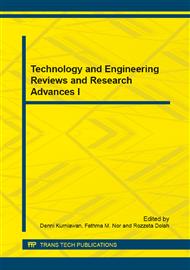p.186
p.190
p.195
p.200
p.205
p.210
p.215
p.220
p.226
Sulphate Reduction Control to Enhance Methane Composition in Anaerobic Digester
Abstract:
The aim of this research is to investigate addition of iron (ferric chloride) to control of sulphate reduction in order to enhance the methane production under laboratory scale. The bioreactor Upflow Anaerobic Sludge Blanket (UASB) undergoes continuous operation under anaerobic condition treating synthetic sulphate enriched wastewater. The wastewater used as influent wastewater with a total COD 8000 mg.L-1. The experiment was conducted for about 64 days and was operated at constant OLR of 2.0(±0.1) kgCOD.m-3.d-1 by maintaining a hydraulic retention time (HRT) of 4 days. The UASB then were feed with sulphate and give the COD/SO4 ratio 5.3, 2.5 and 1.5. Then amount of ferric chloride at 10.4, 22.2 and 44.5 mM was introduce just after methane producing bacteria (MPB) were completely inhibited by sulphate reducing bacteria (SRB) due to decreasing of methane composition (CH4) and high level production of hydrogen sulphide (H2S). The obtained results showed that the FeCl3 negatively impacted the anaerobic digestion process since with each of COD/SO42- ratio, and the amount addition of ferric chloride to feed regime, gives promotion on methane production, with 67, 70 and 69% after approximately 10 to 15 days operating at critical conditions.
Info:
Periodical:
Pages:
205-209
Citation:
Online since:
February 2015
Authors:
Price:
Сopyright:
© 2015 Trans Tech Publications Ltd. All Rights Reserved
Share:
Citation:


